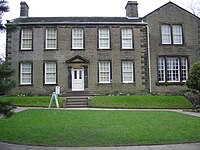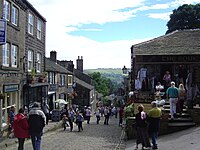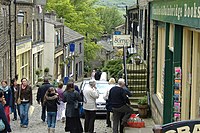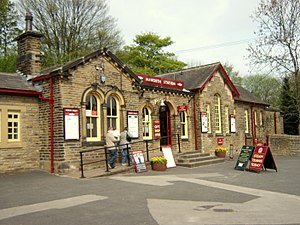Haworth
| Haworth | |
| Yorkshire West Riding | |
|---|---|
 Main Street, Haworth | |
| Location | |
| Grid reference: | SE030372 |
| Location: | 53°49’48"N, 1°57’36"W |
| Data | |
| Population: | 6,379 |
| Post town: | Keighley |
| Postcode: | BD22 |
| Dialling code: | 01535 |
| Local Government | |
| Council: | Bradford |
| Parliamentary constituency: |
Keighley |
Haworth is a historic village in the West Riding of Yorkshire, famed as the home of the Brontë sisters and its landscape as the inspiration for their novels, and this connection brings visitors to Haworth from across the world.
The village also has a station on a preserved heritage railway; the Keighley and Worth Valley Railway.
The village is within the Pennines, lying in the Worth Valley. It is three miles south-west of Keighley and 10 miles west of Bradford. The Lancashire border is close by, Colne in that county is 10 miles to the west.
Nearby villages include Cross Roads, Stanbury and Lumbfoot.
Contents
Economy
Tourism accounts for much of the local economy, with the major attractions being the Brontë Parsonage Museum and the Keighley and Worth Valley Railway.
In Haworth there are tea rooms, souvenir and antiquarian bookshops, restaurants, pubs and hotels including the Black Bull, where Branwell Brontë, brother of the novelist sisters, allegedly began his decline into alcoholism and opium addiction. Haworth is a base for exploring Brontë Country, while still being close to the major cities of Bradford and Leeds.
Churches
St Michael and All Angels Church is situated on Church Street, next to the parsonage. It is part of the Church of England Deanery of Craven.[1]
Baptists in the area met in a barn at the bottom of Brow Road in 1785. They subsequently moved to Hall Green Baptist Church at the junction of Bridgehouse Lane and Sun Street.[2]
History
Haworth is first mentioned as a settlement in 1209.[3] The name is Old English or Middle English and may refer to a "hedged enclosure" or "hawthorn enclosure". The name was recorded as "Howorth" on a 1771 map.
Culture
Haworth's traditional events were an annual service at Haworth Spa and the rush bearing. Spa Sunday died out in the early 20th century and the rush bearing ceremony has not been held for many years. A modern event organised by the Haworth Traders' Association is "Scroggling the Holly" which takes place in November.[4] Bands and Morris men lead a procession of children in Victorian costume following the Holly Queen up the cobblestones to a crowning ceremony on the church steps. She unlocks the church gates to invite the spirit of Christmas into Haworth. Father Christmas arrives bringing glad tidings.
The first Haworth Arts Festival took place in 2000 and was repeated in 2001, but ceased. It was revived in 2005 as a festival combining performing and visual arts and street performance.[5] The festival has community involvement and uses local professional and semi-professional musicians, artists and performers and a larger name to headline each year. The festival has expanded across the Worth Valley outside Haworth and is held on the first weekend in September.
Haworth Band is one of the oldest secular musical organisations in the area.[6] History records indicate that there was a brass band at Ponden, close by in 1854 with a body of excellent performers. It was founded by John Heaton who lived at Ponden. The band played at a celebration in Haworth at the conclusion of the Crimean War. Over the years the world of brass band music went from strength to strength, during which time the Haworth Band went with it.
Every year the village hosts a 1940s weekend where locals and visitors don wartime attire for a host of nostalgic events.
From 1971 to 1988, 25 and 27 Main Street housed the Haworth Pottery where Anne Shaw produced hand-thrown domestic stoneware derived from the arts & crafts tradition. She exhibited widely in the Britain and America in public and private exhibitions and received an arts association award for her ceramic sculptures. Her husband, Robert Shaw, depicted life (and prominent residents) in the village in the 1970s and 80s, in two collections of satires, The Wrath Valley Anthology, 1981, and Grindley's Bairns,1988, praised by The Times Literary Supplement.
Sights of the village
Haworth railway station is part of the Keighley and Worth Valley Railway, an authentic preserved steam railway.
The 43-mile long Brontë Way leads past Lower Laithe Reservoir, Stanbury to the Brontë Waterfall, the Brontë Bridge and the Brontë Stone Chair in which (it is said) the sisters took turns to sit and write their first stories. It then leads out of the valley and up on the moors to Ponden Hall (reputedly Thrushcross Grange in Emily Brontë's Wuthering Heights) and Top Withens, a desolate ruin which was reputedly the setting for the farmstead Wuthering Heights. Top Withens can also be reached by a shorter walking route departing from the nearby village of Stanbury.
Sport
Haworth Cricket Club was established in 1887 as Haworth Wesleyan Cricket Club. They have a permanent ground north of Well Lane, west of the village centre. Haworth West End Cricket Club was formed in 1900 as the Haworth West Lane Baptist Cricket Club.[7]
On 6 July 2014, Stage 2 of the 2014 Tour de France from York to Sheffield, passed through the village.[8]
The Brontës
The Brontë sisters, Charlotte, Emily, and Anne Brontë, were the three novelist daughters of Patrick Brontë, the ‘perpetual curate’ of Haworth from 1820. The Rev Brontë, himself a published poet, was born near Rathfriland in County Down (where a rival 'Brontë Country' is promoted). He moved to Shropshire and at some point changed his name from his family name, Brunty, to Brontë.
The three sisters were born in Thornton near Bradford, but the family moved to Haworth in 1820 when their father was appointed to the parish and the care of the Church of St. Michael and All Angels. Charlotte, Emily, and Anne wrote most of their novels while living at Haworth Parsonage.
In the 19th century, the village and surrounding settlements were largely industrialised, which put it at odds with the popular portrayal in Wuthering Heights, which only bore resemblance to the upper moorland to which Emily Brontë was accustomed.[9]
The Parsonage is now a museum owned and maintained by the Brontë Society.
On film
Haworth and Haworth railway station have been used as settings for numerous period films and television programmes, including:
- The Railway Children (1970 film)
- 'Yanks
- The Wall (Alan Parker's film version of Pink Floyd's
- "Wild Child"
- "The Souk" (a high class vintage shop was depicted as a charity shop)
Outside links
| ("Wikimedia Commons" has material about Haworth) |
- Haworth Online
- "Welcome to Brontë Country", Eagle Intermedia's Bronte Country
- "Discover Haworth and Brontë Country", Visit Bradford
- Knox, James, M.; "The Name Haworth"!
- Haworth Arts Festival
References
- ↑ "St Michael & All Angels, Haworth". http://www.achurchnearyou.com/haworth-st-michael-all-angels/. Retrieved 5 August 2010.
- ↑ "Hall Green Baptist Church – History". http://www.hallgreenchapel.org.uk/history/history.html. Retrieved 5 August 2010.
- ↑ "Haworth Village – Visiting Haworth – England". http://www.haworth-village.org.uk/visitors/visiting-bronte-country/visit-haworth.asp. Retrieved 10 August 2010.
- ↑ "Scroggling the Holly – 20th November". Archived from the original on 23 April 2008. http://web.archive.org/web/20080423025609/http://www.haworthvillage.co.uk/ScrogglingMain.htm. Retrieved 21 August 2010.
- ↑ "Haworth Arts Festival". http://www.haworth-village.org.uk/events/haworth-events/more.asp?event=Haworth%20Arts%20Festival. Retrieved 6 July 2012.
- ↑ "The Haworth Band – History". http://www.thehaworthband.co.uk/history.htm. Retrieved 5 August 2010.
- ↑ "Haworth West End Cricket Club – History". http://www.haworthwestend.org/history.html. Retrieved 14 August 2010.
- ↑ "Tour de France Stage 1". http://www.letour.com/le-tour/2014/us/stage-2.html. Retrieved 15 July 2014.
- ↑ Fraser, Rebecca (1993). "The Brontës". in Marsh, Kate. Writers and Their Homes. Hamish Hamilton. p. 41. ISBN 0-241-12769-6.



